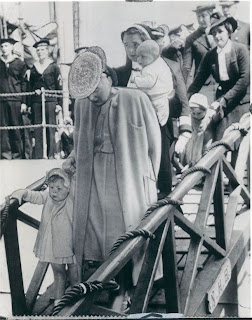Rates to UPU destinations remained stable during this period. However, the inauguration of the Imperial Penny Post (2 cents Canadian) scheme on December 25, 1898 resulted in a significant lowering of letter rates to the United Kingdom and the Empire, i.e., from 5 cents to 2 cents per one-half ounce.
A. United States
1. Letter
a) To December 31, 1898
The letter rate was 3 cents per ounce.
[Not shown]
b) From January 1, 1899
The letter rate to the United States was reduced to 2 cents for each ounce.
Ottawa to Bisbee, Arizona, December 21, 1901
2 cents letter rate to the United States
London to Milford, Del., November 6, 1901
2 cents letter rate to the United States
2. Post Card
The post card rate was 1 cent.
Quebec to Brooklyn, August 16, 1900
1 cent post card rate
Belleville to Lancaster, Mass., October 1, 1900
1 cent post card rate
Toronto to Cincinnati, September 4, 1903
1 cent post card rate
Raphael Tuck & Sons "Empire Post Card" No. 272
3. Registration
The registration fee was 5 cents.
St. John West, N.B., to New York, November 13, 1898
8 cent numeral stamp paying 3 cents letter rate + 5 cents registration fee
4. Acknowledgment of Receipt
The acknowledgment of receipt was 5 cents. The AR fee was paid on the item mailed.
A very rare cover.
Registered letter from Montreal to New Orleans, August 9, 1899
2 cent letter rate + 5 cents registration + 5 cents acknowledgment of receipt fee
B. United Kingdom and British Empire
Letter
a) To December 24, 1898
The letter rate was 5 cents for each one-half ounce.
Great Britain
London, Ontario to London, January 4, 1898
5 cents letter rate
India
Wolfville to Cocanada, India, February 3, 1898
5 cents letter rate
b) From December 25, 1898
The letter rate was reduced to 2 cents for each 1/2 ounce (Imperial Penny Post Scheme).
Halifax & St. John Mail Car to London, July 31, 1899
2 cent Imperial Penny Postage letter rate to England
London receiver
August 12, 1899
Ottawa (House of Commons) to Kingston, Jamaica, April 22, 1899
2 cent Imperial Penny Postage letter rate to Jamaica
Queen Victoria Mourning Cover
Queen Victoria died on January 22, 1901. The mourning cover shown below was mailed to India.
Toronto to East Kirkee, India, March 4, 1901
2 cents Imperial Penny Postage letter rate to India
(Re-directed to Lahore)
C. Universal Postal Union Countries
1. Letter
The UPU letter rate was 5 cents.
Ottawa to Perier-sur-Dan, France, May 7, 1900
5 cents UPU letter rate
Georgetown to Paris, August 2, 1898
1 cent "Letter Card" uprated to 5 cents with 3 cent and 1/2 cent stamps
5 cents UPU letter rate
Halifax to Fredericksted, St. Croix, Virgin Islands (Denmark), July 14, 1899
5 cents UPU letter rate
( Sadly only a front)
2. Post Card
The UPU post card rate was 2 cents.
Prescott to Vegesack, Germany, May 3, 1900
2 cents UPU post card rate
Halifax to Santa Margherita Ligure, Italy, July 9, 1899
2 cents UPU post card rate
Montreal to Vienna, March 6, 1901
2 cents UPU post card rate
Toronto to Brussels, April 17, 1898
Uprated 1 cent Post Card
Brussels receiver April 28, 1898
Universal Postal Union Post Card
Montreal to Leipzig, Germany, February 28, 1902
2 cents UPU Post Card
Niagara Falls to Kobe, Japan, September 12, 1899
2 cents UPU Post Card
San Francisco transit September 16, 1899
Kobe receiver October 19, 1899
3. Printed Matter
The first weight UPU printed matter rate was 1 cent.
London to Hjorring, Denmark, December 11, 1902
1 cent UPU printed matter rate
The Canadian Packing Co. London, Ontario
Hjorring receiver December 24, 1902
Montreal to Lille, France, January 6, 1903
1 cent UPU printed matter rate
4. Registration
The registration fee was 5 cents.
The cover below to Italy is a lovely example showing the UPU registration rate. Unfortunately a 3 cent stamp has fallen off. The stamp was originally below the 2 cent numeral that received the pen cancel. There is gum residue in that location. It is unlikely that the stamp was deliberately removed by a philatelist. With that said :
Two ounce registered letter from Roberval, Quebec, to Bologna Italy, October 30, 1898
(Remaining postage on the envelope : 12 cents)
10 cents letter rate (double weight) + 5 cents registration fee
The missing stamp was probably pen-cancelled as well.
A scarce mailing from Dawson, Yukon, is shown next.

'
Dawson, Yukon Territory to Frieberg, Germany, June 3, 1903
The UPU letter rate was 5 cents for each 1/2 ounce.
10 cents letter rate for 1 ounce ( 2 x 5 cents/ 1/2 ounce) + 5 cents registration fee


































_McCord_Museum_McGill.jpg)






























 '
'